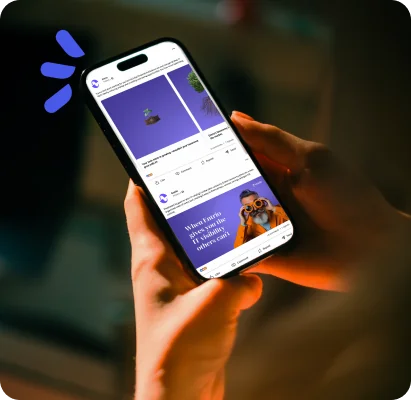
Inbound marketing is the behind-the-scenes workhorse of modern growth strategies. It helps you attract, engage and build real trust with the right audience—all by creating content that actually helps them.
But here’s the kicker: even though inbound is one of the most effective long-term strategies out there, too many companies still miss the mark.
In this blog, we’ll break down:
- Why inbound marketing is worth investing in
- Common missteps that could be holding you back
- Practical solutions to help you move forward with confidence
Why inbound is still one of the smartest marketing plays
Inbound marketing isn’t a shiny new trend—it’s a long-term strategy that continues to drive results, even as the digital landscape shifts.
At its core, inbound marketing is about providing real value to the right audience at the right time. Instead of interrupting people with aggressive outreach or irrelevant ads, inbound invites them in with helpful, relevant content that solves a problem, answers a question, or offers a new insight.
What makes inbound so effective is its ability to meet your audience where they are, especially early in the buying journey. Rather than pushing your solution, you’re building trust by demonstrating that you understand your audience and their needs. That trust pays off over time—in brand affinity, lead quality and ultimately, revenue.
Still, even the best intentions can go off track. Here’s how to avoid common pitfalls and build an inbound strategy that actually works.
Your 8-step inbound marketing plan (and what to avoid along the way)
1. Start with real buyer personas—not just job titles
Mistake: Targeting audiences based only on job titles
Many companies start their inbound strategy by targeting job titles, like “Director of Operations” or “IT Manager.” But a job title only tells you what someone does, not who they are, how they make decisions, or what they care about. When personas are too shallow, your messaging becomes generic… and it won’t stick.
Solution: Create detailed, human-centered personas
To build marketing that resonates, you need a deeper understanding of your audience’s mindset and motivations. Go beyond demographics—create buyer personas and dig into the details that shape their behavior.
A strong buyer persona should include:
- Day-to-day responsibilities: What does their job actually look like in practice?
- Pain points: What challenges are they trying to solve?
- Motivations: What outcomes do they care most about—saving time, hitting goals, reducing risk?
- Buying behaviors: Are they budget holders? Do they rely on peer input or data?
- Emotional drivers: What stresses them out? What makes them feel successful?
- Preferred channels: Where do they go to research? LinkedIn? Google? Peers?
When you know your audience on this level, your messaging, content and offers will land with more clarity and relevance—because they’ll actually reflect the real people you’re trying to reach.
2. Align your sales and marketing teams early
Mistake: Treating sales and marketing as separate functions
When sales and marketing operate in silos, your inbound strategy suffers. Marketing might generate leads that sales doesn’t consider qualified. Sales might miss follow-ups or dismiss leads that don’t match their expectations. The result? Frustration, finger-pointing and missed opportunities.
Solution: Build alignment around shared goals and clear processes
When sales and marketing are working toward the same goals with shared language and expectations, everything flows more smoothly—from lead handoff to closed-won.
Start by building alignment in these areas:
- Lead definitions: Agree on what qualifies as a Marketing Qualified Lead (MQL), Sales Qualified Lead (SQL) and other lifecycle stages.
- Handoff process: Document how leads move from marketing to sales, including timing, ownership and follow-up steps.
- Shared goals: Set unified targets, such as pipeline generated or conversion rates, so both teams are incentivized to collaborate.
- Regular check-ins: Create space for feedback loops between teams to refine targeting, messaging and content strategy.
- Closed-loop reporting: Use tools like HubSpot or Salesforce to track lead outcomes and share insights across both teams.
When both teams understand and support each other’s roles, you create a smoother experience for your prospects—and a stronger path to revenue.
3. Let keyword research guide your content strategy
Mistake: Creating content without understanding search intent
You might have the most thoughtful, well-designed content in your industry, but if no one’s searching for it, it won’t get found. Skipping keyword research means you’re guessing at what your audience wants instead of meeting them where they already are. That’s a fast track to wasted effort and underperforming campaigns.
Solution: Use keyword research to shape topics and drive visibility
Keyword research ensures your content aligns with real demand. When you understand what your audience is typing into search engines, you can create content that addresses their needs and shows up at the right time.
Here’s how to get started:
- Use SEO tools: Platforms like Google Keyword Planner, SEMrush and Ahrefs help uncover what your audience is searching for and how competitive those terms are.
- Focus on long-tail keywords: These are more specific phrases that reflect real intent—think “best CRM for startups” instead of just “CRM.”
- Analyze SERPs: Look at what’s already ranking to understand searcher expectations and content formats (lists, guides, videos, etc.).
- Optimize key elements: Place keywords naturally in your:
- Post title
- Page title and URL
- Headings and subheadings
- Meta description
- Image alt text
- Body copy (about 3–6 mentions, depending on length)
- Avoid keyword stuffing: Content should always be written for people first, search engines second.
When you let keyword data guide your content strategy—and use SEO best practices—you increase the chances your content will not only be discovered, but actually be useful to the person reading it.
4. Create high-value content offers that solve real problems
Mistake: Publishing content that’s too generic or self-serving
If your content only talks about your product or repeats what’s already out there, it’s unlikely to stand out. Generic content may fill a calendar, but it won’t drive engagement or build trust. And if your offers are overly promotional, your audience will tune out before they ever convert.
Solution: Deliver content that’s genuinely useful, relevant and actionable
Effective inbound content helps your audience do something better—whether that’s solving a problem, improving a process or learning a new skill. Your offer should serve a specific purpose and be tailored to your persona’s stage in the buyer’s journey.
To create a high-value content offer:
- Focus on the problem: Start by identifying what your audience is struggling with and how you can help them solve it.
- Choose the right format: Match the content type to the complexity of the topic and the depth of insight needed. Popular formats include:
- Ebooks or guides
- Checklists or cheat sheets
- Webinars or on-demand videos
- Case studies or customer stories
- Product demos or free trials
- Worksheets, templates or calculators
- Avoid the hard sell: Your offer should provide value on its own—even if the reader never becomes a customer.
- Make it skimmable: Break up content with headers, bullets and visuals so it’s easy to navigate.
When your content is genuinely helpful and easy to consume, it builds trust and keeps your audience coming back for more.
5. Build a landing page designed to convert
Mistake: Sending traffic to a page that lacks clarity or direction
You’ve created a valuable offer, but if your landing page is cluttered, confusing or missing a strong CTA, your conversion rate will suffer. A weak landing page turns warm interest into dead ends.
Solution: Create focused, benefit-driven pages with clear next steps
Your landing page should quickly communicate what the offer is, why it matters and how to get it. Every element on the page should work toward that single goal. Here’s how to optimize for conversion:
- Write a strong headline: Use clear, benefit-focused language to grab attention and show the value of the offer.
- Keep the copy concise: Explain what the visitor will get and why it’s worth their time or information.
- Use a single CTA: Avoid giving multiple paths—make the next step obvious.
- Simplify the form: Only ask for the information you truly need to qualify the lead.
- Design for clarity: Use visual hierarchy to guide the eye, and remove navigation or distractions that pull visitors away.
Also, consider whether the content should be gated or ungated:
- Gated: Use for high-value, educational content like guides, webinars or in-depth research. The reader is likely willing to exchange their info for access.
- Ungated: Use for sales-focused content like brochures or product videos. If someone’s ready to learn more about your company, don’t block their path.
A well-built landing page works hard for you, helping you turn traffic into leads without any added friction.
6. Promote your content across every relevant channel
Mistake: Assuming your content will get discovered on its own
Hitting “publish” is just the beginning. Without a promotion plan, even your most valuable content can sit untouched. Many teams invest time in content creation but skip the follow-through, limiting the return on their effort.
Solution: Build a repeatable plan to get your content in front of the right people
Promotion is what turns content into pipeline. It ensures the right audience actually sees—and acts on—what you’ve created. Instead of relying on organic reach alone, be proactive and consistent in how you share your content.
Here’s how to do it:
- Leverage your owned channels: Use your email list, blog, newsletter and social media platforms to distribute content to people already connected to your brand.
- Repurpose across formats: Turn a guide into social snippets, short videos or a webinar promo. More formats mean more chances to reach people.
- Schedule and reshare: Promotion isn’t one and done. Re-share content multiple times over weeks or months to give it a longer life.
- Use paid channels strategically: Paid search and social ads (we love LinkedIn Ads) can help extend reach and drive more targeted traffic—especially when you’re testing a new offer or targeting a niche persona.
- Tap into partners: If your offer is co-branded or relevant to a broader ecosystem, consider promotion through influencer relationships or strategic partnerships.
The more consistently and creatively you promote, the more traffic and leads your content will generate.
7. Set up automated workflows to nurture your leads
Mistake: Stopping the conversation after someone downloads your content
If your follow-up ends with the form submission, you’re leaving value on the table. Many businesses put time and energy into creating content and driving conversions but don’t nurture those leads once they’ve converted. Without follow-up, leads go cold, and your campaign loses momentum.
Solution: Use automated workflows to build relationships over time
Lead nurturing helps move prospects through the funnel by continuing to deliver value after the initial conversion. Automated workflows make it easy to stay top of mind and relevant without overwhelming your team.
To create an effective nurture sequence:
- Tailor content to the original offer: Use what the lead downloaded or engaged with as a starting point. If they grabbed a guide on scaling operations, follow up with related blog posts, checklists or case studies.
- Use a series, not a single email: Plan a sequence that unfolds over time, delivering educational content and light brand touchpoints before making a direct offer.
- Set timing carefully: Avoid bombarding your leads. Leave space between messages, and use behavior-based triggers when possible.
- Include soft CTAs: Not every message needs to push a demo or sales call. Give leads opportunities to engage at their own pace.
- Monitor and refine: Review email performance to see which messages get clicks, and adjust your content or timing accordingly.
When your nurture sequences are intentional and well-structured, they keep your audience engaged, shorten your sales cycle and increase the chances of converting leads into customers.
8. Track what’s working—and optimize from there
Mistake: Running campaigns without measuring performance
You can’t improve what you’re not measuring. Too often, teams launch inbound campaigns, generate leads and move on without taking the time to analyze what actually worked. Without visibility into performance, it’s hard to replicate success or fix what’s broken.
Solution: Use data to guide decisions and refine your strategy over time
Inbound marketing is a long game, and consistent tracking helps you get better with each campaign. Reviewing performance data shows you what’s resonating with your audience, where leads are coming from and how different touchpoints contribute to conversions.
To build a strong analytics habit:
- Set up tracking URLs: Use UTM parameters to see which channels and assets are driving traffic and conversions.
- Monitor key metrics: Look at pageviews, form submissions, bounce rates, time on page, email open and click rates, and conversion rates over time.
- Track lead quality: Go beyond volume—follow leads through the funnel to see which content sources bring in the most qualified prospects.
- Create feedback loops: Share learnings across teams so both marketing and sales can adjust tactics, messaging or outreach based on performance.
- Use the data to iterate: Look at what worked, what didn’t and what can be tested next time. Even small adjustments can lead to meaningful improvements.
When you treat your data like a roadmap, you can double down on what’s working, drop what’s not and continuously raise the bar.
Inbound marketing is a long game worth playing
Inbound marketing isn’t about quick wins or flashy tactics—it’s about building a strategy that delivers consistent, long-term results. When you understand your audience, avoid common missteps and approach each campaign with intention, you’re setting your business up to attract better leads, nurture stronger relationships and grow with purpose.
Ready to launch an inbound strategy that actually drives growth?
Subscribe to our newsletter
Curated content, news articles, team updates and more.



